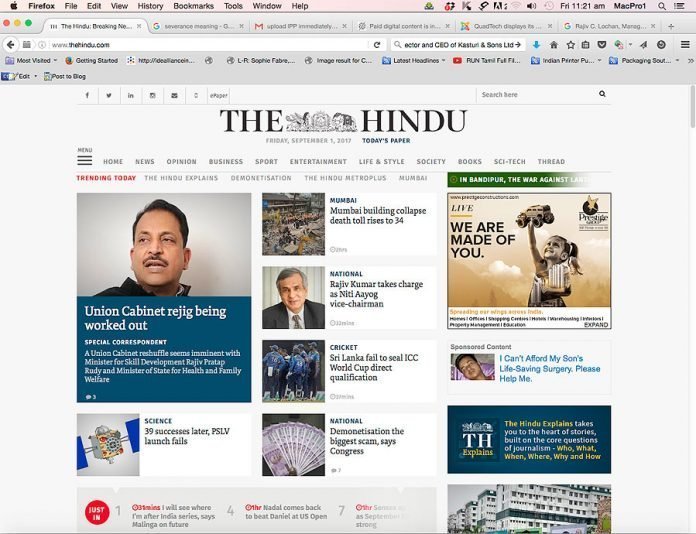In the Indian newspaper market, which is dominated by an advertising-led approach, The Hindu is transforming its 138-year old organization by means of a reader-centric, print-led, technology-enabled model. Leading the upstream swim at one of the country’s most respected media organizations is Rajiv C. Lochan, Managing Director and CEO of Kasturi & Sons Ltd.
Although Lochan will speak on “Reader-centric print transformation: An emerging markets perspective” at the upcoming World Publishing Expo (see details below), we chose to ask him about The Hindu‘s digital operations and their role in the company’s future. The interview took place via e-mail.
WAN-IFRA: Assuming that digital display advertising will never become a substantial money-earner, what measures are you taking to generate revenue from your digital operations? What future do you see for user-paid digital content at your company?
Rajiv Lochan: It is our considered belief that obsessing on our readers and their experience with our products and services is paramount to our existence. In this context, a reliance on digital display advertising is challenging and we would agree that this can never be a material commercial contributor.
 Rajiv C. Lochan, managing director and CEO of Kasturi & Sons. Photo INMA
Rajiv C. Lochan, managing director and CEO of Kasturi & Sons. Photo INMA
Our approach to our digital business is a “string of pearls” where each pearl represents an offering at a cherry-picked reader sub-segment and the offering distinctively serves the needs of the sub-segment. The commercial model of each pearl will be a judicious balance of advertising, subscription and transaction revenues. Across the string of pearls, our belief is that we will become the pre-eminent destination of choice for the chosen segments of readers and our commercial model will smartly balance the three sources of revenues highlighted. User-paid digital content will consequently be an important part of our future!
Do you have a staff of programmers building the technology used for your digital services, or do you look to external providers for your platforms? Please discuss the advantages of your approach.
We adopt a hybrid model currently, with a team of in-house developers as well as a set of external providers. Product design and business analysis are entirely done in-house. Our bias is to systematically build in-house capabilities and rely less and less on external providers.
In short, our endeavour is to move in our capabilities and mindset from being primarily a publishing business to a digital product business over time.
In what ways are you attempting to instill a “startup culture” as a means of stimulating innovation at Kasturi & Sons?
This is a significant challenge, as well as an opportunity. We have the benefit of an unparalleled reputation for journalistic integrity and technological pre-emption over the past several decades. We also have a strong history of employee benevolence. As a 138-year old institution, building a modern, performance-oriented entrepreneurial culture is an onerous task but when done with a focus on our legacy and reputation, it is a remarkable opportunity.
We are attempting as many avenues as possible to learn – from creating ring-fenced teams focused on specific products to separate subsidiaries to develop new businesses!
I understand that the Hindu is testing software that algorithmically screens user comments. Could you describe the testing, and tell us about the timeframe – when do you anticipate such a system being put into daily use?
It is still too early to comment on this. In my view, this is another illustration of our willingness and eagerness to learn and experiment with emerging technologies. On this particular instance, we are still in the process of reviewing findings. Early results are encouraging and if these continue, I would expect that we will put it to use sooner rather than later.
Reprinted by permission of Wan-Ifra. (Editor’s note: For a more extensive interview with Rajiv Lochan, please see the July/August 2016 issue of Asian News Media Focus, which is available in ePaper form free of charge.) Lochan will give the Closing Keynote address during the Mastering Present And Future session at the World Publishing Expo, 15:30-17:00 Thursday, 12 October, in Berlin. Anton Jolkovski is the Managing Editor at WAN-IFRA based in Frankfurt, Germany. He can be contacted at ++49-69-240063-263 or anton.jolkovski@wan-ifra.org











